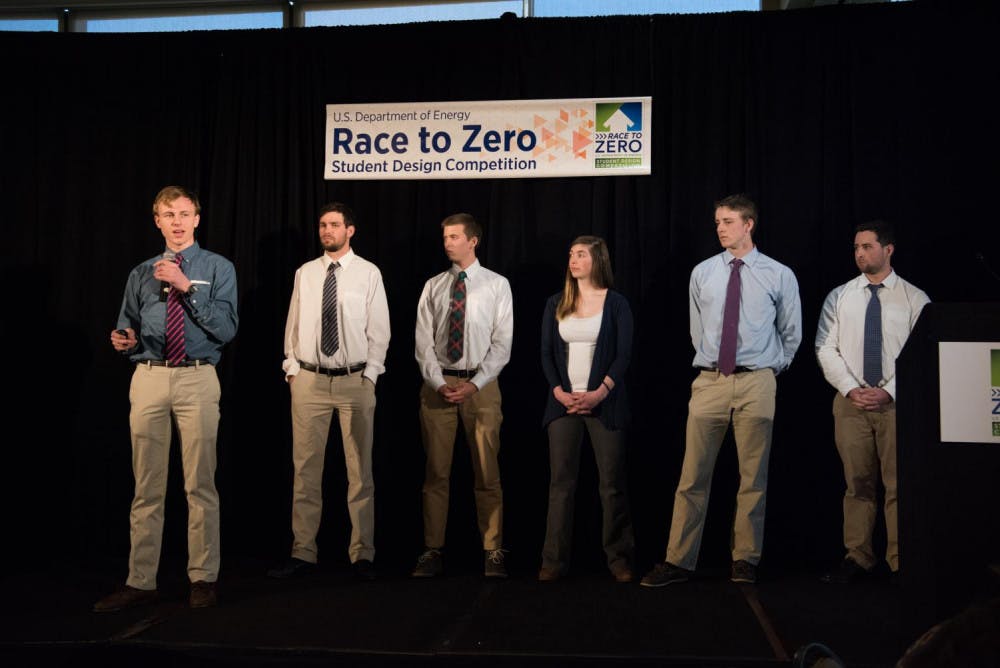The Middlebury Race to Zero team won the elementary schools contest in the U.S. Department of Energy’s annual Race to Zero Student Design competition held in Golden, Colorado from April 20-22. The college competed against 40 teams from 34 colleges and universities to design marketable, economically feasible and fully renewable buildings.
“In a monumental upset, our rag tag liberal arts team took first place in the Race to Zero Elementary Design competition,” wrote Alex Browne ’18 on the Middlebury Race to Zero team blog.
The contest was designed by the Department of Energy to engage students who are interested in architecture, engineering, construction and similar disciplines in thinking creatively about renewable and clean energy. Students were asked to update building designs and create plans for high-performance, energy-efficient buildings where renewable power could offset at least most of the energy consumption of the space.
Project manager Zach Berzolla ’18 learned of the competition through director of sustainability integration Jack Byrne. He worked with geology professor Will Amidon to develop a student-taught winter term class focused on Zero Energy building design. The course was designed to teach students about the Zero Energy design process by developing a design for a Zero Energy elementary school in Vermont.
Over winter term and the spring semester, the team designed a two-story, 21-classroom, 500-student facility, which they believed would best suit Middlebury’s residents and the Vermont climate.
Representatives from the college’s team presented their final redesign of local Mary Hogan Elementary School at the College’s Student Symposium on April 20 and again in front of a Department of Energy jury at the National Renewable Energy Lab on April 22. The college’s team won the contest while competing against schools with graduate architecture and engineering programs.
“Our team’s victory was a testament to the value of a liberal arts education,” said Browne, who was responsible for making sure Middlebury’s elementary school design was up to code. He noticed that some other teams’ plans were not.
Browne said his experience as a volunteer firefighter made him especially conscious of fire safety and building code compliance. He also said the team’s attention to detail meant all aspects of the final design were carefully thought out, which some other teams lacked.
Many members of the Middlebury team cited the importance of their holistic approach. The group began by studying existing Zero Energy schools before meeting with the principal of Mary Hogan Elementary, Tom Buzzel, to better understand the elementary school’s specific needs.
“Then as a class we decided on key pieces we wanted to include in our design and what the most important components were,” Berzolla said.
“In our early stages, our team spent what seemed to be an unreasonable number of hours arguing about every detail; from the number of faucets in a bathroom all the way up to recent changes in elementary school pedagogy,” Browne said.
Berzolla said the team spent two months refining the floor plans because every decision was intentionally chosen to create the best learning environment possible.
Later on, the team broke into smaller working groups that focused on specific categories including architecture, interior design and HVAC systems. Berzolla said that with every design choice, the group weighed cost, energy-efficiency and the design goals.
“We had to dive into a very detailed analysis of the mechanical, electrical, and plumbing systems for the building,” Berzolla said, although no team members had sufficient experience with these areas. Assistance from industry partners made the project feasible and gave the final design its depth.
Instead of modifying a standard design for the new elementary school, the college team discussed what the future of education should look like, and used those innovative concepts as the basis for their plan.
“We focused heavily on collaborative and experiential learning and our design tried to make this natural and easy,” said Gigi Miller ’18, a member of the interior design team. She said they aimed to create spaces that kids would be excited to come and learn in everyday.
Berzolla said this focus on the kids and creating the building as a teaching tool that students would be excited to learn in was what set them apart from other schools in the competition.
“We really tried to think about specific social factors such as different learning and teaching styles that may need to be catered to,” said Emma McDonagh ’19, who worked on the building’s architecture. Her group redesigned the current building’s convoluted layout to create more welcoming and flexible interior spaces.
The new school’s location was another important factor. The team selected a space beside the current middle school because of its flexibility and its connection with the outdoors. McDonagh said that such real-world implications made the project a great learning experience.
The team plans to present their plan to the Middlebury Selectboard in May.
Student-Led Zero Energy Team Wins National Prize for Elementary School Design

Comments



